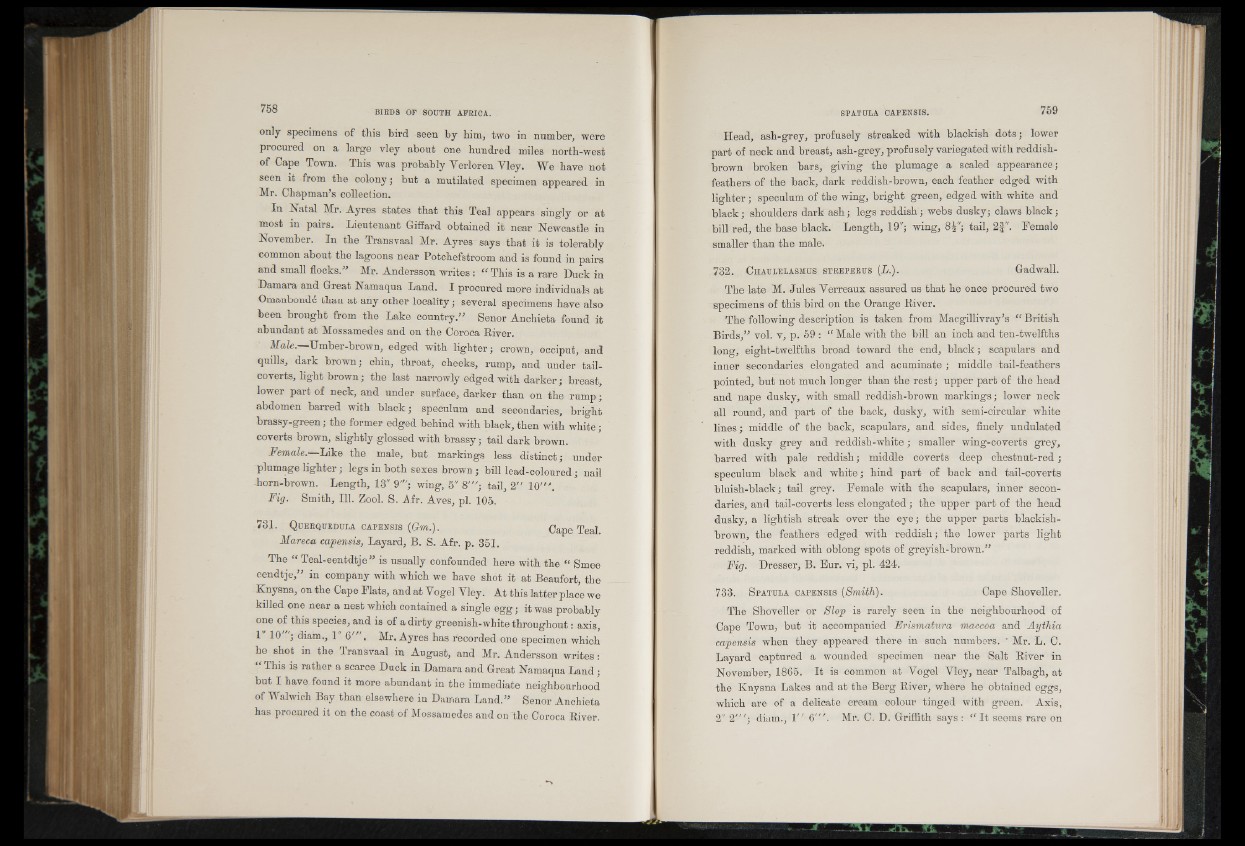
only specimens of this bird seen by him, two in number, were
procured on a large vley about one hundred miles north-west
of Cape Town. This was probably Yerloren Vley. We have not
seen it from the colony; but a mutilated specimen appeared in
Mr. Chapman’s collection.
In Natal Mr. Ayres states that this Teal appears singly or at
most in pairs. Lieutenant Giffard obtained it near Newcastle in
November. In the Transvaal Mr. Ayres says that it is tolerably
common about the lagoons near Potchefstroom and is found in pairs
and small flocks." Mr. Andersson writes: “ This is a rare Duck in
Damara and Great Namaqua Land. I procured more individuals at
Omanbonde than at any other locality; several specimens have also
been brought from the Lake country." Senor Anchieta found it
abundant at Mossamedes and on the Coroca River.
Male. Umber-brown, edged with lighter; crown, occiput, and
quills, dark brown; chin, throat, cheeks, rump, and under tail-
coverts, light brown; the last narrowly edged with darker; breast,
lower part of neck, and under surface, darker than on the rump;
abdomen barred with black; speculum and secondaries, bright
brassy-green; the former edged behind with black, then with white;
coverts brown, slightly glossed with brassy; tail dark brown.
Female.—Like the male, but markings less distinct; under
plumage lighter; legs in both sexes brown; bill lead-coloured; nail
horn-brown. Length, 18" 9'"; wing, 5" 8'"; tail, 2" 10'".
Fig. Smith, 111. Zool. S. Afr. Aves, pi. 105.
781. Q o e r q u e d u l a c a p e n s i s (Grn.) . Cape Teal
Mareca capensis, Layard, B. S. Afr. p. 351.
The “ Teal-eentdtje" is usually confounded here with the “ Smee
eendtje," in company with which we have shot it at Beaufort, the
Knysna, on the Cape Plats, and at Vogel Vley. At this latter place we
killed one near a nest which contained a single egg; it was probably
one of this species, and is of a dirty greenish-white throughout: axis,
1 10 ; d-iam,, 1 6 . Mr. Ayres has recorded one specimen which
he shot in the Transvaal in August, and Mr. Andersson writes:
“ This is rather a scarce Duck in Damara and Great Namaqua Land;
but I have found it more abundant in the immediate neighbourhood
of Walwich Bay than elsewhere in Damara Land." Senor Anchieta
has procured it on the coast of Mossamedes and on 'the Coroca River.
Head, ash-grey, profusely streaked with blackish dots; lower
part of neck and breast, ash-grey, profusely variegated with reddish-
brown broken bars, giving the plumage a scaled appearance;
feathers of the back, dark reddish-brown, each feather edged with
lighter; speculum of the wing, bright green, edged with white and
black; shoulders dark ash; legs reddish; webs dusky; claws black;
bill red, the base black. Length, 19"; wing, 84"; tail, 2 |". Female
smaller than the male.
732. C haulelasmus s tr e per u s (L.). Gad wall.
The late M. Jules Verreaux assured us that he once procured two
specimens of this bird on the Orange River.
The following description is taken from Macgillivray’s “ British
Birds,” vol. v, p. 59 : “ Male with the bill an inch and ten-twelfths
long, eight-twelfths broad toward the end, black; scapulars and
inner secondaries elongated and acuminate ; middle tail-feathers
pointed, but not much longer than the rest; upper part of the head
and nape dusky, with small reddish-brown markings; lower neck
all round, and part of tbe back, dusky, with semi-circular white
lines; middle of the back, scapulars, and sides, finely undulated
with dusky grey and reddish-white; smaller wing-coverts grey,
barred with pale reddish; middle coverts deep chestnut-red;
speculum black and white; hind part of back and tail-coverts
bluish-black; tail grey. Female with the scapulars, inner secondaries,
and tail-coverts less elongated; the upper part of the head
dusky, a lightish streak over the eye; the upper parts blackish-
brown, the feathers edged with reddish; the lower parts light
reddish, marked with oblong spots of greyish-brown."
Fig. Dresser, B. Bur. vi, pi. 424.
733. S patula c a pen s is [Smith). Cape Shoveller.
The Shoveller or Slop is rarely seen in the neighbourhood of
Cape Town, but it accompanied Frismatura maccoa and Aythia
capensis when they appeared there in such numbers. ' Mr. L. C.
Layard captured a wounded specimen near the Salt River in
November, 1865. It is common at Vogel Vley, near Talbagh, at
the Knysna Lakes and at the Berg River, where he obtained eggs,
which are of a delicate cream colour tinged with green. Axis,
2" 2'"; diam., 1" 6"'. Mr. C. D. Griffith says : “ It seems rare on